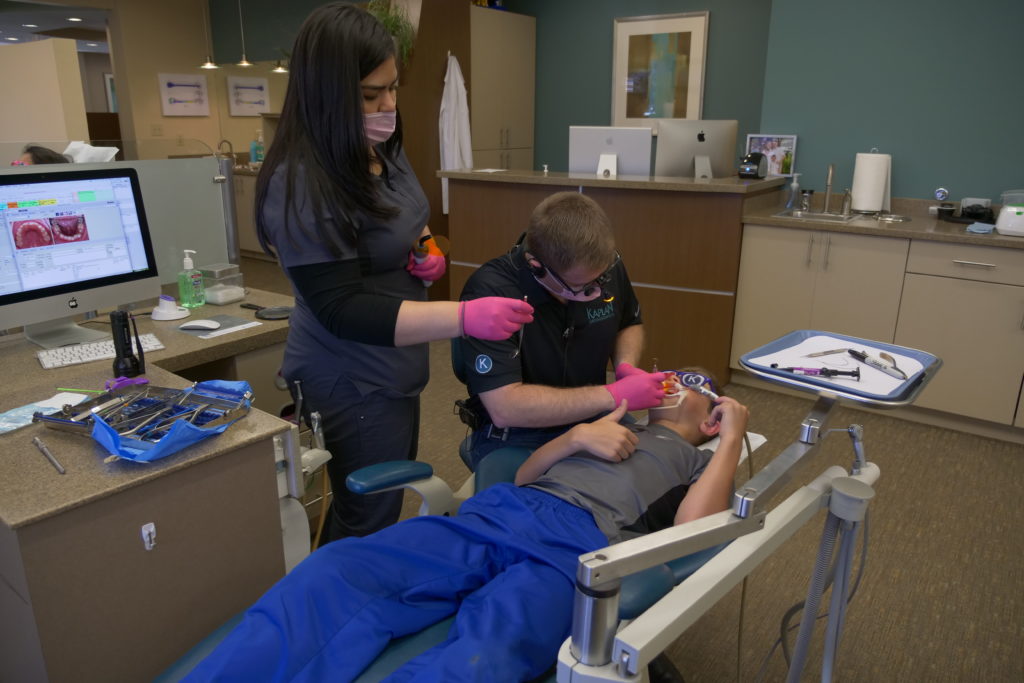
Best Dental Hygiene Routine For Braces
When it comes to achieving a beautifully aligned smile, it’s a team effort between you, the team here at Kaplan Orthodontics, and your general dentist. In fact, as an orthodontic patient, you actually play a key role in how successful your treatment process is! By following Dr. Kaplan’s directions and recommendations, you’ll be able to get the most out of the orthodontic process, and maintaining a good dental hygiene routine is one of the best ways to keep your teeth, gums, and braces clean and in great shape. In order to get the best results, you need to make sure your mouth is free from pesky plaque and bad bacteria. Proper dental care with braces may take a little extra time and effort, but it’s more than worth it when your brand new smile is revealed! Keep reading below to learn more about the best way to care for your braces, and how an excellent oral hygiene routine can help you achieve a smile you’ll be proud to show off.
What is plaque?
Plaque is a sticky, colorless film that’s composed of bacteria, food, and saliva. If it’s not brushed or rinsed away properly, it can collect on your teeth. When plaque and other food debris is left lingering on your teeth and around your braces, it can lead to a number of dental issues, such as:
An increased risk for cavities and decalcification
The bacteria in plaque reacts with the sugars and starches in food, and can form an acid that eats away at the enamel on your teeth. This may lead to cavities, white marks on the teeth, or even gum disease. If you allow plaque to accumulate around your braces, it can leave stains on your teeth called decalcification. Sadly, the lines and spots from decalcification are permanent, so this is one area where an ounce of prevention is definitely worth a pound of cure!
Periodontal disease
Periodontal disease is more commonly referred to as gum disease, and is caused by a buildup of plaque on the teeth. It generally occurs in three distinct stages.
The first stage is gingivitis, which occurs when an accumulation of plaque becomes significant enough to irritate the gums. In response, they may be puffy, swollen, or bleed slightly when you brush or floss.
If this buildup of plaque is left in place, it can harden into a substance called tartar. As tartar accumulates, gaps or pockets may form between your gums and teeth. This allows even more tartar to collect in the pockets, leading to the second stage of periodontal disease, called periodontitis.
When periodontitis goes untreated, pockets of bacteria can form and deepen beneath your gums, attacking the bone that anchors your teeth and eventually destroying it. This advanced periodontitis can cause even healthy teeth to loosen or fall out, and is the third stage of gum disease. It’s also the most serious.
Fortunately, early gum disease can usually be reversed with expert professional help and good follow-up care at home. But because gum disease is often painless, you’ll need to know the signs of it and pay close attention to any symptoms like bleeding, swollen, or puffy gums. By carefully following Dr. Kaplan’s recommendations for caring for your braces, you can help keep plaque, bacteria, and tooth decay at a minimum.
The best dental hygiene for braces
Oral hygiene becomes especially important when you’re undergoing orthodontic treatment. Braces can make it challenging to clean your teeth and gums effectively, but without the proper care and attention, dental issues can develop. These are frustrating enough to deal with on their own, but they can also cause secondary oral health issues if left untreated. This can extend the total treatment time, and in more severe cases, your braces may need to be removed while we wait for any mouth and gum issues to be resolved. To avoid spending extra time in braces or delaying the treatment process, try incorporating the following tips into your daily oral hygiene routine.
Brushing with Braces
Braces often require you to adjust both the way you brush your teeth and how often you do it. We recommend you brush your teeth after every meal (preferably after every snack) and before bed for at least four to five minutes each time to keep food particles and plaque from gaining a foothold in your braces and teeth. To correctly brush teeth with braces, you should:
- Hold your soft-bristled toothbrush parallel to the floor against the side of the teeth, and begin moving the toothbrush in small circular motions, following the regular curve of the gums and teeth as you go from tooth to tooth.
- Brush each tooth for several seconds, carefully and slowly. Take special care to remove any food particles along the gum line, between the braces, and on the surface of each tooth.
- Remember to brush the tops of teeth and insides of your teeth, the back of your mouth, and behind the molars. Brush upward on the lower teeth and downward on the upper teeth, and brush your tongue before rinsing.
- To properly clean the brackets, angle the brush head against them. Don’t forget to brush thoroughly under the wires as well!
Flossing with braces
Flossing can be tricky at the best of times, and it tends to have an even bigger learning curve when you’re wearing braces. It’s still a critical part of the orthodontic process, however, and something you should be doing every night before bed. Even if it seems like all food debris has been brushed away, braces are known for trapping food particles in places that are hard to see and reach. To correctly floss with braces, you should:
- Choose a piece of floss about 18 inches long and slide it under the wire, above the space between the two teeth. Insert the floss halfway through, and then hold both ends of the floss. Carefully slide the floss up and down a few times between the teeth. You’ll hear a slight squeaking sound when it’s thoroughly clean.
- Floss the gum line with the floss in the shape of a “C,” and below the gum line with a soft up and down motion. Be careful not to apply too much pressure when flossing around the archwire.
- It is also important to make sure to not just floss between the teeth but also clean the area under the gum tissue.
- Gently remove the floss, threading it under the next wire, and repeating the steps above.
Thorough flossing can take a while with braces, especially in the beginning, but you’ll get faster the more you practice, so be patient! We also recommend checking out some of the products available that have been designed to make dental hygiene easier for patients in braces. For example, “threader floss” has a stiff end that permits flossing between brackets, and the orthopick easily slides between your teeth and the bracket wire to remove debris and keep your smile fresh and clean. Interproximal brushes can slip under your archwire to get rid of any plaque and food particles near your brackets, and oral irrigators offer a targeted, pressurized stream of water to make brushing and rinsing much more efficient.
Keep your braces looking their best with Kaplan Orthodontics
While it’s exciting working towards a straighter, healthier smile, we know it can also come with its own set of challenges. Caring for your braces can seem a little complicated in the early days, but before you know it, it will be just another part of your daily routine! Our talented team is committed to keeping your orthodontic journey as safe, stress-free, and positive as possible. If you have any questions or concerns about caring for your braces, please get in touch and we’ll do all we can to keep a smile on your face!



